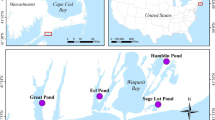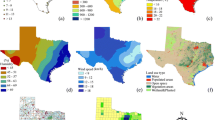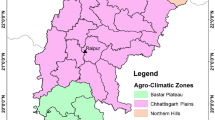Abstract
Vertical turbulent fluxes of water vapour, carbon dioxide, and sensible heat were measured from 16 August to the 28 September 2006 near the city centre of Münster in north-west Germany. In comparison to results of measurements above homogeneous ecosystem sites, the CO2 fluxes above the urban investigation area showed more peaks and higher variances during the course of a day, probably caused by traffic and other varying, anthropogenic sources. The main goal of this study is the introduction and establishment of a new gap filling procedure using radial basis function (RBF) neural networks, which is also applicable under complex environmental conditions. We applied adapted RBF neural networks within a combined modular expert system of neural networks as an innovative approach to fill data gaps in micrometeorological flux time series. We found that RBF networks are superior to multi-layer perceptron (MLP) neural networks in the reproduction of the highly variable turbulent fluxes. In addition, we enhanced the methodology in the field of quality assessment for eddy covariance data. An RBF neural network mapping system was used to identify conditions of a turbulence regime that allows reliable quantification of turbulent fluxes through finding an acceptable minimum of the friction velocity. For the data analysed in this study, the minimum acceptable friction velocity was found to be 0.15 m s−1. The obtained CO2 fluxes, measured on a tower at 65 m a.g.l., reached average values of 12 μmol m−2 s−1 and fell to nighttime minimum values of 3 μmol m −2 s−1. Mean daily CO2 emissions of 21 g CO2 m−2d −1 were obtained during our 6-week experiment. Hence, the city centre of Münster appeared to be a significant source of CO2. The half-hourly average values of water vapour fluxes ranged between 0.062 and 0.989 mmol m−2 s−1and showed lower variances than the simultaneously measured fluxes of CO2.
Similar content being viewed by others
References
Alduchov OA, Eskridge RE (1996) Improved Magnus form approximation of saturation vapor pressure. J Appl Meteorol 35: 601–609
Arya SP (2001) Introduction to Micrometeorology, 2nd edn. Academic Press, San Diego, 420 pp
Armor JN (2007) Addressing the CO2 dilemma. Catal Lett 114: 115–121
Aubinet M, Grelle A, Ibrom A, Rannik U, Moncrieff J, Foken T, Kowalski AS, Martin PH, Berbigier P, Bernhofer C, Clement R, Elbers J, Granier A, Grünwald T, Morgenstern K, Pilegaard K, Rebmann C, Snijders W, Valentini R, Vesala T (2000) Estimates of the annual net carbon and water exchange of European forests: The EUROFLUX methodology. Adv Ecol Res 30: 113–175
Baldocchi D (2003) Assessing the eddy covariance technique for evaluating carbon dioxide exchange rates of ecosystems: past, present and future. Global Change Biol 9: 479–492
Bakker B, Heskes T (2003) Clustering ensembles of neural network models. Neural Netw 16: 261–269
Barron AR (1994) Approximation and estimation bounds for artificial neural networks. Mach Learn 14: 115–133
Bishop CM (1995) Neural networks for pattern recognition. Oxford University Press, Oxford, 482 pp
Breiman L (1996) Bagging predictors. Mach Learn 24: 123–140
Broomhead DS, Lowe D (1988) Multivariable functional interpolation and adaptive networks. Complex Syst 2: 321–355
Buck AL (1981) New equations for computing vapor pressure and enhancement factor. J Appl Meteorol 20: 1527–1532
Coutts AM, Beringer J, Tapper NJ (2007) Characteristics influencing the variability of urban CO2 fluxes in Melbourne, Australia. Atmos Environ 41: 51–62
De Bruin HAR, Hartogensis OK (2005) Variance method to determine turbulent fluxes of momentum and sensible heat in the stable atmospheric surface layer. Boundary-Layer Meteorol 116: 385–392
De Haan P, Rotach MW, Werfeli M (2001) Modification of an operational dispersion model for urban applications. J Appl Meteorol 40: 864–879
Dobesch H (1982) The determination of windenergy within a region with probability functions of the wind velocity. Meteorol Atmos Phys 30: 355–368
Falge E, Baldocchi D, Olson RJ, Anthoni P, Aubinet M, Bernhofer C, Burba G, Ceulemans R, Clement R, Dolman H, Granier A, Gross P, Grünwald T, Hollinger D, Jensen N-O, Katul G, Keronen P, Kowalski A, Ta Lai C, Law BE, Meyers T, Moncrieff J, Moors E, Munger JW, Pilegaard K, Rebmann C, Rebmann C, Suyker A, Tenhunen J, Tu K, Verma S, Vesala T, Wilson K, Wofsy S (2001a) Gap filling strategies for defensible annual sums of net ecosystem exchange. Agric Forest Meteorol 107: 43–69
Falge E, Baldocchi D, Olson RJ, Anthoni P, Aubinet M, Bernhofer C, Burba G, Ceulemans R, Clement R, Dolman H, Granier A, Gross P, Grünwald T, Hollinger D, Jensen N-O, Katul G, Keronen P, Kowalski A, Ta Lai C, Law BE, Meyers T, Moncrieff J, Moors E, Munger JW, Pilegaard K, Rebmann C, Rebmann C, Suyker A, Tenhunen J, Tu K, Verma S, Vesala T, Wilson K, Wofsy S (2001b) Gap filling strategies for longterm energy flux data sets. Agric Forest Meteorol 107: 71–77
Finnigan JJ, Clement R, Malhi Y, Leuning R, Cleugh HA (2003) A re-evaluation of long-term flux measurement techniques. Part I: averaging and coordinate rotation. Boundary-Layer Meteorol 107: 1–48
Foken T, Wichura B (1996) Tools for quality assessment of surface-based flux measurements. Agric Forest Meteorol 78: 83–105
Foken T, Göckede M, Mauder M, Mahrt L, Amiro BD, Munger JW (2004) Post-field data quality control. In: Lee X, Massman W, Law B (eds) Handbook of micrometeorology: a guide for surface flux measurement and analysis. Kluwer Academic Publishers, Dordrecht, pp 181–208
Foken T (2006) Angewandte Meteorologie Mikrometeorologische Methoden, 2nd edn. Springer, Berlin, 326 pp
Gerosio F, Poggio T (1990) Networks and the best approximation property. Biol Cybern 63: 169–176
Ghodsi A, Schuurmans D (2003) Automatic basis selection techniques for RBF networks. Neural Netw 16: 809–816
Golub GH, Kahan W (1965) Calculating the singular values and pseudo-inverse of a matrix. SIAM J Numer Anal 2: 205–224
Golub GH, Reinsch C (1970) Singular value decomposition and least squares solutions. Numer Math 14: 403–420
Goulden ML, Munger JW, Fan S-M, Daube BC, Wofsy SC (1996) Measurements of carbon sequestration by long-term eddy covariance: methods and critical evaluation of accuracy. Global Change Biol 2: 169–182
Grimmond CSB, Oke TR (2000) Heat fluxes and stability in North American cities. In: Preprints of the third urban environment symposium, Davis, California, American Meteorological Society (eds) Boston, MA, pp 28–29
Grimmond CSB, King TS, Cropley FD, Nowak DJ, Souch C (2002) Local-scale fluxes of carbon dioxide in urban environments: Methodological challenges and results from Chicago. Environ Pollut 116: 243–254
Grimmond CSB, Salmond JA, Oke TR, Offerle B, Lemonsu A (2004) Flux and turbulence measurements at a densely built-up site in Marseille: heat, mass (water and carbon dioxide), and momentum. J Geophys Res 109: D24101, doi: 10.1029/2004JD004936
Grünwald T, Bernhofer C (2000) Data gap filling with regression modelling. In: Ceulemans RJM, Veroustrate F, Gond V, Van Rensbergern JBHF (eds) Forest ecosystem modelling, upscaling and remote sensing.. SPB Academic Publishing bv, The Hague, The Netherlands, pp 61–67
Gu L, Falge EM, Boden T, Baldocchi DD, Black TA, Saleska SR, Suni T, Verma SB, Vesala T, Wofsy SC, Xu L (2005) Objective threshold determination for nighttime eddy flux filtering. Agric Forest Meteorol 128: 179–197
Hammerle A, Haslwanter A, Schmitt M, Bahn M, Tappeiner U, Cernusca A, Wohlfahrt G (2007) Eddy covariance measurements of carbon dioxide, latent and sensible energy fluxes above a meadow on a mountain slope. Boundary-Layer Meteorol 122: 397–416
Hanna SR, White J, Zhou Y (2007) Observed winds, turbulence, and dispersion in built-up downtown areas in Oklahoma city and Manhattan. Boundary-Layer Meteorol (in press). doi: 10.1007/s10546-007-9197-2
Hansen LK, Salamon P (1990) Neural network ensemble. IEEE Trans Pattern Anal Mach Learn 12: 993–1001
Haykin S (1999) Neural networks: a comprehensive foundation, 2nd edn. Prentice Hall Upper Saddle River, NJ, 842 pp
Hecht-Nielsen R (1987) Kolmogorov’s mapping neural network existence theorem. Proc Int Conf Neural Networks, IEEE Press, New York, pp 11–14
Hestenes M (1980) Conjugate Direction methods in optimization. Springer, New York, 325 pp
Hollinger DY, Aber J, Dail B, Davidson EA, Goltz M, Hughes H, Leclerc MY, Lee JT, Richardson AD, Rodrigues C, Scott NA, Achuatavarier D, Walsh J (2004) Spatial and temporal variability in forest atmosphere CO2 exchange. Global Change Biol 10: 1689–1706
Hui D, Wan S, Su B, Katul G, Monson R, Luo Y (2004) Gap-filling missing data in eddy covariance measurements using multiple imputation (MI) for annual estimations. Agric Forest Meteorol 121: 93–111
Hunter A, Kennedy L, Henry J, Ferguson RI (2000) Application of neural networks and sensitivity analysis to improved prediction of trauma survival. Comput Meth Prog Bio 62: 11–19
Iwata H, Malhi Y, von Randow C (2005) Gap-filling measurements of carbon dioxide storage in tropical rainforest canopy airspace. Agric Forest Meteorol 132: 305–314
Jolliffe IT (2002) Principal component analysis, 2nd edn. Springer, New York, 502 pp
Kaplan JO, New M (2006) Arctic climate change with a 2°C global warming: Timing, climate patterns and vegetation change. Clim Change 79: 213–241
Lagouarde J-P, Irvine M, Bonnefond J-M, Grimmond CSB, Oke TR, Salmond J, Offerle B (2006) Monitoring the sensible heat flux over urban areas using large aperture scintillometry: case study of Marseille city during the ESCOMPTE experiment. Boundary-Layer Meteorol 118: 449–476
Liebethal C, Foken T (2003) On the significance of the Webb correction to fluxes. Boundary-Layer Meteorol 109: 99–106
Light WA (1992) Some aspects of radial basis function approximation. In: Singh SP (eds) Approximation theory, spline functions and applications. Kluwer Academic Publishers, Dordrecht, pp 163–190
Likas A, Vlassis N, Verbeek JJ (2003) The global k-means clustering algorithm. Pattern Recogn 36: 451–461
MacQueen J (1965) On convergence of k-means and partitions with minimum average variance. Ann Math Statist 36: 1084
Massman WJ, Lee X (2002) Eddy covariance flux corrections and uncertainties in long term studies of carbon and energy exchanges. Agric Forest Meteorol 113: 121–144
Metcalfe E, Teteh J, Howells SL (1996) Optimisation of radial basis and backpropagation neural networks for modelling auto-ignition temperature by quantitative-structure property relationships. Chemom Intell Lab Sys 32: 177–191
Miglietta F, Gioli B, Hutjes RWA, Reichstein M (2007) Net regional ecosystem CO2 exchange from airborne and ground-based eddy covariance, land-use maps and weather observations. Global Change Biol 13: 548–560
Moncrieff J, Clement R, Finnigan J, Meyers T (2004) Averaging, detrending, and filtering of eddy covariance time series. In: Lee X, Massman W, Law B (eds) Handbook of Micrometeorology: a guide for surface flux measurement and analysis. Kluwer Academic Publishers, Dordrecht, pp 7–31
Ooba M, Hirano T, Mogami JI, Hirata R, Fujinuma Y (2006) Comparisons of gap-filling methods for carbon flux dataset: a combination of a genetic algorithm and an artificial neural network. Ecol Model 198: 473–486
Oost WA, Oost EM (2004) An alternative approach to the parametrization of the momentum flux over the sea. Boundary-Layer Meteorol 113: 411–426
Papale D, Valentini R (2003) A new assessment of European forest carbon exchanges by eddy fluxes and artificial neural network spatialization. Global Change Biol 9: 525–535
Patterson DW (1996) Artificial Neural Networks. Prentice Hall, Singapore, 477 pp
Perrin O, Rootzén H, Taesler R (2006) A discussion of statistical methods used to estimate extreme wind speeds. Theor Appl Climatol 85: 203–215
Perrone MP, Cooper LN (1993) When networks disagree: ensemble methods for hybrid neural networks. In: Mammone RJ (eds) Artificial neural networks for speech and vision. Chapman and Hall, London, pp 126–147
Qu M, Shih FY, Jing J, Wang H (2003) Automatic solar flare detection using MLP, RBF, and SVM. Sol Phys 217: 157–172
Vesala T, Vesala T (1999) Autoregressive filtering versus linear detrending in estimation of fluxes by the eddy covariance method. Boundary-Layer Meteorol 91: 259–280
Reichstein M, Falge E, Baldocchi D, Papale D, Aubinet M, Berbigier P, Bernhofer C, Buchmann N, Gilmanov T, Granier A, Grünwald T, Havránková K, Ilvesniemi H, Janous D, Knohl A, Laurila T, Lohila A, Loustau D, Matteucci G, Meyers T, Miglietta F, Ourcival J-M, Pumpanen J, Rambal S, Rotenberg E, Sanz M, Tenhunen J, Seufert G, Vaccari F, Vesala T, Yakir D, Valentini R (2005) On the separation of net ecosystem exchange into assimilation and ecosystem respiration: review and improved algorithm. Global Change Biol 11: 1424–1439
Ripley BD (2005) Pattern recognition and neural networks. Cambridge University Press, Cambridge, p p 403
Rumelhart DE, Hinton GE, Williams RJ (1986) Learning internal representations by error propagation. In: Rumelhart DE, McClelland JL, the PDP Research Group (eds) Parallel distributed processing: explorations in the microstructure of cognition vol. 1: Foundations. MIT Press, Cambridge, MA, pp 318–362
Ruppert J, Mauder M, Thomas C, Lüers J (2006) Innovative gap-filling strategy for annual sums of CO2 net ecosystem exchange. Agric Forest Meteorol 138: 5–18
Schimel DS, House JI, Hibbard KA, Bousquet P, Ciais P, Peylin P, Braswell BH, Apps MJ, Baker D, Bondeau A, Canadell J, Churkina G, Cramer W, Denning AS, Field CB, Friedlingstein P, Goodale C, Heimann M, Houghton RA, Melillo JM, Moore B, Murdiyarso D, Noble I, Pacala SW, Prentice IC, Raupach MR, Rayner PJ, Scholes RJ, Steffen WL, Wirth C (2001) Recent patterns and mechanisms of carbon exchange by terrestrial ecosystems. Nature 414: 169–172
Seguro JV, Lambert TW (2001) Discussion on modern estimation of the parameters of the Weibull wind speed distribution for wind speed energy analysis. J Wind Eng Ind Aerod 89: 867–869
Solomon S, Qin D, Manning M, Alley RB, Berntsen T, Bindoff NL, Chen Z, Chidthaisong A, Gregory JM, Hegerl GC, Heimann M, Hewitson B, Hoskins BJ, Joos F, Jouzel J, Kattsov V, Lohmann U, Matsuno T, Molina M, Nicholls N, Overpeck J, Raga G, Ramaswamy V, Ren J, Rusticucci M, Somerville R, Stocker TF, Whetton P, Wood RA, Wratt D (2007) Technical summary. In: Qin SD, Manning M, Chen Z, Marquis M, Averyt KB, Tignor M, Miller HL (eds) Climate change 2007: the physical science basis. Contribution of Working Group I to the Fourth Assessment Report of the Intergovernmental Panel on Climate Change. Cambridge University Press, Cambridge, UK, New York, NY, USA, 996 pp
Stauch V, Jarvis J (2006) A semi-parametric gap-filling model for eddy covariance CO2 flux time series data. Global Change Biol 12: 1707–1716
Tirozzi B, Puca S, Pittalis S, Bruschi A, Morucci S, Ferraro E, Corsini S (2006) Neural networks and sea time series—Reconstruction and Extreme-Event Analysis. Birkhäuser, Boston, 179 pp
Troen I, Petersen EL (1989) European wind Atlas. Risø National Laboratory, Roskilde Denmark, 656 pp
Velasco E, Pressley S, Allwine E, Westberg H, Lamb B (2005) Measurements of CO2 fluxes from the Mexico City urban landscape. Atmos Environ 39: 7433–7446
Vogt R, Christen A, Rotach MW, Roth M, Satyanarayana ANV (2006) Temporal dynamics of CO2 fluxes and profiles over a Central European city. Theor Appl Climatol 84: 117–126
Webb EK, Pearman GI, Leuning R (1980) Correction of the flux measurements for density effects due to heat and water vapour transfer. Quart J Roy Meteorol Soc 106: 85–100
Wilczak JM, Oncley SP, Stage SA (2001) Sonic anemometer tilt correction algorithms. Boundary-Layer Meteorol 99: 127–150
Wilson DR, Martinez TR (2003) The general inefficiency of batch training for gradient descent learning. Neural Networks 16: 1429–1451
Zhang WD, He MX, Mak MW (2001) Application of MLP and RBF networks to cloud detection. Proc Int Sym Intelligent Multimedia Video and Speech Processing, Hong Kong, May 2001, pp 60–63
Zurada JM, Malinowski A, Cloete I (1994) Sensitivity analysis for minimization of input data dimension for feedforward neural network. Proc Int Sym Circuits and Systems, London, February 1994, IEEE Press, 447–450
Author information
Authors and Affiliations
Corresponding author
Rights and permissions
About this article
Cite this article
Schmidt, A., Wrzesinsky, T. & Klemm, O. Gap Filling and Quality Assessment of CO2 and Water Vapour Fluxes above an Urban Area with Radial Basis Function Neural Networks. Boundary-Layer Meteorol 126, 389–413 (2008). https://doi.org/10.1007/s10546-007-9249-7
Received:
Accepted:
Published:
Issue Date:
DOI: https://doi.org/10.1007/s10546-007-9249-7




